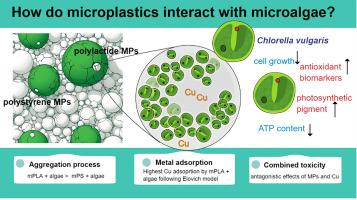When microplastics meet microalgae: Unveiling the dynamic formation of aggregates and their impact on toxicity and environmental health
IF 12.4
1区 环境科学与生态学
Q1 ENGINEERING, ENVIRONMENTAL
引用次数: 0
Abstract
Microplastics (MPs) commonly coexist with microalgae in aquatic environments, can heteroaggregate during their interaction, and potentially affect the migration and impacts of MPs in aquatic environments. The hetero-aggregation may also influence the fate of other pollutants through MPs' adsorption or alter their aquatic toxicity. Here, we explored the hetero-aggregation process and its key driving mechanism that occurred between green microalga Chlorella vulgaris (with a cell size of 2–10 μm) and two types of MPs (polystyrene and polylactide, 613 μm). Furthermore, we investigated the environmental impacts of the microplastics-microalgae aggregates (MPs-microalgae aggregates) by comparing their adsorption of Cu(II) with that of pristine MPs and evaluating the effects of hetero-aggregation on MPs aging and their toxicity to microalgae. Our results indicated that microalgal colonization occurred on the surface of MPs, possibly through electrostatic interactions, hole-filling, hydrophilic interactions, and algae-bacteria symbiosis. The hetero-aggregation led to a stronger Cu(II) adsorption by MPs-microalgae aggregates than pristine MPs due to electrostatic interactions, coordination, complexation, and ion exchange. Exposure to either MPs (pristine or aged) or Cu(II) inhibited the cell growth of C. vulgaris, while the integrated biomarker response (IBR) showed more pronounced inhibitory effects resulting from aged MPs compared to pristine MPs and an antagonistic effect on microalgae was caused by the co-exposure to MPs and Cu(II). These findings suggest that the hetero-aggregation of MPs and microalgae may alter their environmental fates and co-pollutant toxicity.


当微塑料遇到微藻:揭示聚集体的动态形成及其对毒性和环境健康的影响
微塑料(MPs)在水生环境中通常与微藻共存,在相互作用过程中会发生异聚集,并可能影响MPs在水生环境中的迁移和影响。异聚集也可能通过MPs的吸附影响其他污染物的命运或改变其水生毒性。本文研究了绿微藻小球藻(细胞尺寸为2 ~ 10 μm)与两种MPs(聚苯乙烯和聚乳酸,613 μm)之间的异聚集过程及其关键驱动机制。此外,我们通过比较微塑料-微藻聚集体(MPs-微藻聚集体)与原始MPs对Cu(II)的吸附,并评估异聚集对MPs老化的影响及其对微藻的毒性,研究了微塑料-微藻聚集体对环境的影响。结果表明,微藻可能通过静电相互作用、空穴填充、亲水性相互作用和藻菌共生等方式在MPs表面定植。由于静电相互作用、配位作用、络合作用和离子交换,异聚集导致MPs-微藻聚集体比原始MPs对Cu(II)的吸附更强。暴露于MPs(原始或老化)或Cu(II)均可抑制C. vulgaris的细胞生长,而综合生物标志物反应(IBR)显示,与原始MPs相比,老化MPs对微藻的抑制作用更为明显,同时暴露于MPs和Cu(II)对微藻产生拮抗作用。这些发现表明MPs和微藻的异聚集可能改变它们的环境命运和共污染物毒性。
本文章由计算机程序翻译,如有差异,请以英文原文为准。
求助全文
约1分钟内获得全文
求助全文
来源期刊

Water Research
环境科学-工程:环境
CiteScore
20.80
自引率
9.40%
发文量
1307
审稿时长
38 days
期刊介绍:
Water Research, along with its open access companion journal Water Research X, serves as a platform for publishing original research papers covering various aspects of the science and technology related to the anthropogenic water cycle, water quality, and its management worldwide. The audience targeted by the journal comprises biologists, chemical engineers, chemists, civil engineers, environmental engineers, limnologists, and microbiologists. The scope of the journal include:
•Treatment processes for water and wastewaters (municipal, agricultural, industrial, and on-site treatment), including resource recovery and residuals management;
•Urban hydrology including sewer systems, stormwater management, and green infrastructure;
•Drinking water treatment and distribution;
•Potable and non-potable water reuse;
•Sanitation, public health, and risk assessment;
•Anaerobic digestion, solid and hazardous waste management, including source characterization and the effects and control of leachates and gaseous emissions;
•Contaminants (chemical, microbial, anthropogenic particles such as nanoparticles or microplastics) and related water quality sensing, monitoring, fate, and assessment;
•Anthropogenic impacts on inland, tidal, coastal and urban waters, focusing on surface and ground waters, and point and non-point sources of pollution;
•Environmental restoration, linked to surface water, groundwater and groundwater remediation;
•Analysis of the interfaces between sediments and water, and between water and atmosphere, focusing specifically on anthropogenic impacts;
•Mathematical modelling, systems analysis, machine learning, and beneficial use of big data related to the anthropogenic water cycle;
•Socio-economic, policy, and regulations studies.
 求助内容:
求助内容: 应助结果提醒方式:
应助结果提醒方式:


